

Doug Smith's Ancient Coins. Reading Japanese Numbers and Dates. As I've previously discussed, it is useful for a world coin collector to be able to read numbers and dates in different languages.
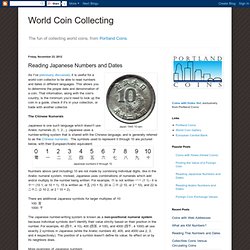
This allows you to determine the proper date and denomination of a coin. That information, along with the coin's country, is the minimum you'd need to look up the coin in a guide, check if it's in your collection, or trade with another collector. The Chinese Numerals Japanese is one such language which doesn't use Arabic numerals (0, 1, 2...). Japanese uses a number-writing system that is shared with the Chinese language, and is generally referred to as the Chinese numerals.
Numbers above (and including) 10 are not made by combining individual digits, like in the Arabic numeral system. There are additional Japanese symbols for larger multiples of 10: 100: 百 1000: 千 The Japanese number-writing system is known as a non-positional numeral system because individual symbols don't identify their value strictly based on their position in the number. The History of Japanese Coins. The First Mintage Phase The next phase of coin use was in the early eighth century when Japan introduced its own mint.

This mint came about when a large deposit of copper was found in Musashi province. Copper was discovered in the Chichibu District of what is now Saitama Prefecture, and the Japanese were so delighted with the discovery that they named the Wado era (708 A.D. – 715 A.D.) after it. Wado means “Japanese Copper” and the first coin that was minted was the Wado Kaiho, or Wado Kaichin, in 708 A.D. The Wado Kaiho was modeled after the Kaigen Tsuho (K’ai Yuan T’ung Pao in Chinese), and whilst the majority were cast in copper, a few were also cast in silver. The Wado Kaiho has two distinct varieties. Over 250 years from 708 A.D. to 958 A.D. the Japanese minted 12 coins. After the final of the 12 coins, the Kengen Taiho, was minted in 958 A.D. Calendrier japonais. Composition de la date Pour indiquer la date sur une pièces, les Japonais donnent l'année du règne de l'empereur et son nom.

La date se repère au caractère 年 qui signifie "année". Comme le sens d'écriture a changé au cours de l'histoire, on trouvera le caractère 年 à gauche de la date sur les pièces anciennes et à droite sur les pièces récentes. Par exemple, sur la pièce ci-contre, on lit "昭和三十六年", ce qui signifie "année 36 (三十六) du règne de l'empereur Shōwa (昭和)", soit 1961. Convertisseur Apprendre à lire une date japonaise La date est généralement écrite sous la forme : [Nom de l'empereur] [Numéro de l'année] 年. Reading Japanese Numbers and Dates. Reading Coin Dates. Japanese numbers: Pre-1867 coins require more expert help than is given here.
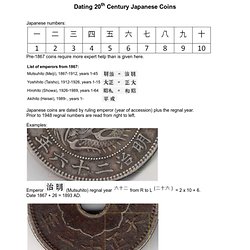
Japanese coins are dated by ruling emperor (year of accession) plus the regnal year. Prior to 1948 regnal numbers are read from right to left. Examples: Emperor (Mutsuhito) regnal year from R to L = 2 x 10 + 6. (Yoshihito) regnal year = 10 + 1. After 1948 (reform coinage) regnal numbers are read left to right. (Hirohito) regnal year (now L to R) = 5 x 10 + 6 = 56. Since the 1960s fifty yen and higher denomination coins use western numbers for the regnal year. (Hirohito). The symbol denotes the 1st year of the reign. Japan mon in Coins & Paper Money. RARE Japan Kanei Tsuho Sen 1 Mon Kameido Mint 1737 Japon Antique Coin Gembun 2. Place bid Review and confirm your bid.
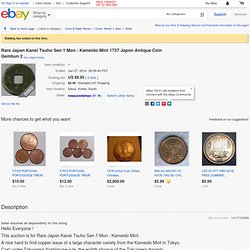
Antique Japan Kanei Tsuho Ashio Sen Edo Kampou Year 1 Japanese 1 Mon Old Coin 2. Place bid Review and confirm your bid Bid confirmation d h.
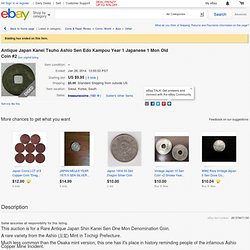
Very RARE Japan Kanei Tsuho Sen 1 Mon TSU Kanji Cast Error Japon Antique Coin. Place bid Review and confirm your bid Bid confirmation d h m s day.

RARE Japan Kanei Tsuho Sen Edo Shogun Gembun Year 2 Japanese 1 Mon Old Coin 1737. Place bid Review and confirm your bid Bid confirmation d h m s day hour hours FREE shipping See item description.
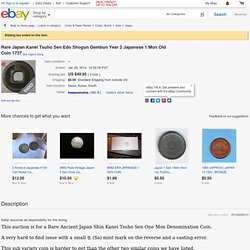
The History of Japanese Coins. Japanese mon (currency) Kan'ei Tsūhō (寛永通宝) coins.
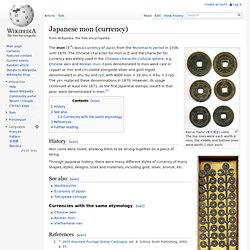
The top ones were each worth 4 mon, the middle and bottom ones were worth 1 mon each. Bunkyū ēhō (文久永宝). Branched ("Edasen" 枝銭) Mon coins of the Bunkyū period. This shows the foundry technique to make the coins: the coins would then be clipped and filed to obtain the final round shape. The mon (文?) Mon coins were holed, allowing them to be strung together on a piece of string. Through Japanese history, there were many different styles of currency of many shapes, styles, designs, sizes and materials, including gold, silver, bronze, etc. Titsingh, Isaac. (1834).